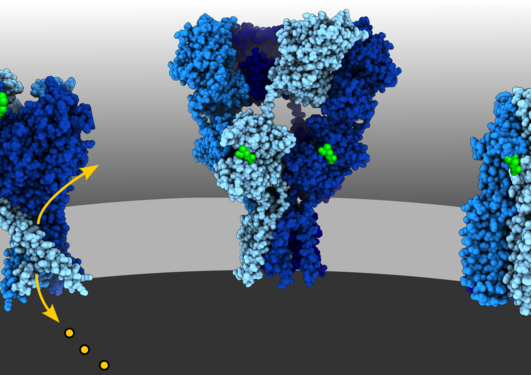A surprising mode of activation for ion channels discovered in a small marine invertebrate
In a new article, researchers from the Lynagh group explore the unexpected activation of an ion channel by a family of small molecules known to inhibit other similar channels .

Main content
A recent study published in the Journal of Biological Chemistry reveals the surprising behavior of a specific ion channel in the brachiopod Novocrania anomala, a marine invertebrate commonly known as a lamp shell. Ion channels are proteins that regulate the flow of ions across cell membranes, and their function is crucial for processes like sensation, fast signals between nerve cells, and muscle contraction. The new study, led by Josep Martí-Solans, sheds light on how these channels interact with small molecules called diarylamidines. These molecules are commonly used as antiparasitic drugs as they are able to strongly bind DNA. Understanding their effect on cell communication is essential to understand the mechanisms underlying their therapeutic effect.
The research focused on a channel belonging to the DEG/ENaC/ASIC family, which is widely studied for its role in sensory functions across animals. Using electrophysiological techniques and molecular biology, the team expressed the channel in frog eggs and analyzed how different diarylamidines influenced its activity. The findings showed that these molecules act as activators - a unique behavior not seen in closely related channels. "The fact that diminazene, pentamidine, and DAPI could turn this channel "on" rather than block it was not only surprising but also intriguing”, Martí-Solans explained. “It made us question what structural or evolutionary differences in this channel might allow for such unique behavior, which added an exciting layer of exploration to the study.”
“It made us question what structural or evolutionary differences in this channel might allow for such unique behavior, which added an exciting layer of exploration to the study.” - Josep Martí-Solans
The story behind the discovery is a testimony to the occasional serendipitous nature of the scientific process. “I tested diminazene on the channel by mistake”, Martí-Solans said. “I wasn’t expecting much, but I saw something totally unexpected - it activated the channel in a way I hadn’t anticipated. That moment was a game-changer and led to the discoveries we explore in the paper.”
The significance of this research extends beyond brachiopods. Understanding how diarylamidines activate this channel could inspire the development of drugs targeting related channels. " Next, we should identify the natural molecules that activate this channel. Detailed structural studies could help explain how this activation works", Martí-Solans added.
The study was conducted in collaboration with Aina Børve, Head Engineer in the group of Prof. Andreas Hejnol at the Department of Biological Sciences. By studying a non-model marine organism, the team has opened new doors to better understand how ion channels and electrical signals control biological processes in animals.
